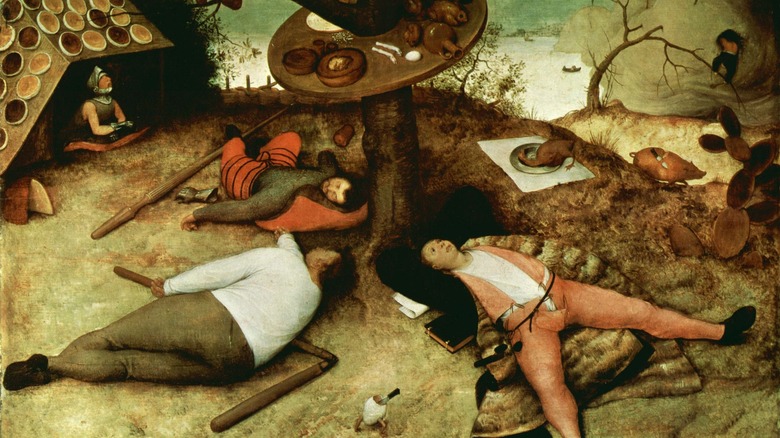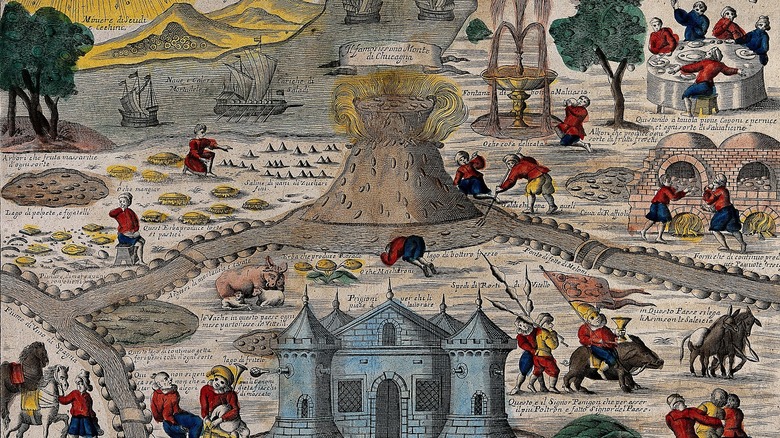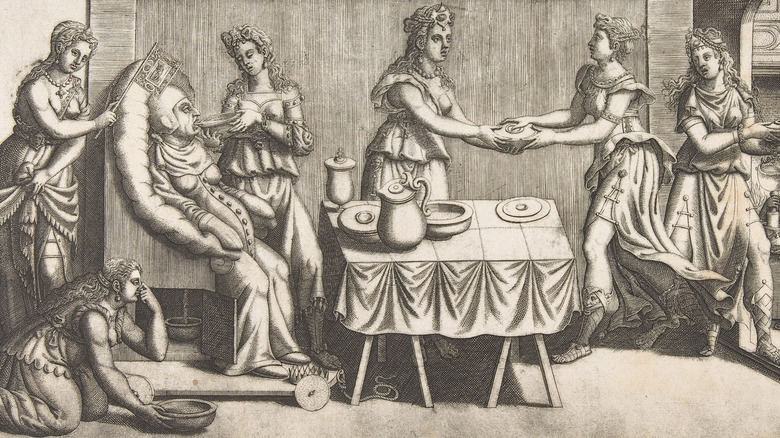The Strange Medieval Fairy-Tale Of Cockaigne, Land Of Laziness And Earthly Delights
You know how the fantasy goes: If only you travel far enough away from the source of your woes, then you can finally be happy. And when you arrive in that fictionally perfect land somewhere far, far in the East, West, North, or South there'll be no labor, no strife, no suffering, no night, no penury, and no death. There'll be no farm animals, either, because they poop everywhere. There'll be no foxes or snakes because they're daily harassments while tending your land. There'll be springs gushing forth wine and medicine, and monks and nuns engaging in casual midnight sorties that God doesn't judge. The sloth is the ultimate animal of admiration, and daily life is a lazy bacchanal of pleasure, idleness, and literal rivers flowing with milk and honey.
At least, this is one version of paradise. If you did random man-on-the-street interviews with Europeans circa the 1300s and asked them, "What does paradise look like?," you might get the above description of the Land of Cockaigne: the standard go-to utopia of late medieval times, per Atlas Obscura. Cockaigne has unknown origins, spread to an unknown extent, lasted for an unknown amount of time, and spread more among the well-to-do, not peasants. But, Cockaigne definitely reveals the concerns of the age. Modern utopian visions might predictably focus on economic or social equality. But for folks living on the European subcontinent 700 or so years ago? Their heaven-on-Earth was a place where they had enough food.
[Featured image by The Yorck Project via Wikimedia Commons | Cropped and scaled]
A paradise shared by all peoples
Cockaigne first appears in print in the 1250 C.E. French poem "Fabliau de Cocagne" — "land of plenty" — a kind of fairy tale meets social satire that focuses largely on abundant food but also contains plenty of unrestricted sex, a fountain of youth, endless money, and no labor whatsoever, as Alimentarium describes. So basically, despite Cockaigne reflecting the concerns of the time, nothing's really changed. Per Arthive, "Cocagne" in France became "Cokaygne" in Britain, "Cuccagna" or "Bengodi" in Italy, "Jauja" in Spain, "Luilekkerland" in the Netherlands, "Schlaraffenlan" in Germany, and more. Because Cockaigne spread into the public consciousness through a book, it's likely that the illiterate peasantry didn't play a role in its proliferation.
Paradise took on different flavors in different regions, like in Giovanni Boccaccio's "Decameron," a 100-story novel published in 1353 only a handful of telling years after the Black Death hit Florence in 1348. Per Alimentarium, Italian paradise was a place, "Where the vines are tied up with sausages and a goose is to be had for a farthing and a gosling into the bargain," and there was "a mountain all of grated Parmesan cheese, whereon abode folk who did nothing but make macaroni and ravioli and cook them in capon-broth." There was also "a rivulet of vernage [sweet wine], the best ever was drunk, without a drop of water therein." In fact, a lack of water for any other purpose besides bathing is common across all versions of Cockaigne.
[Featured image by Wellcome Images via Wikimedia Commons | Cropped and scaled | CC BY 4.0]
From fairy tale to morality tale
Visually, the strongest version we've got of Cockaigne comes from Flemish painter Pieter Bruegel (circa 1525 to 1569) in the Netherlands and can be seen on the digital art museum Arthur. Bruegel's 1567 painting, titled "The Land of Cockaigne," shows three men lounging under a tree that pours wine into open mouths, a rooftop full of pancakes, a half-eaten egg walking around on legs, and more. Bruegel, however, might have co-opted the image to cast judgment on the "gluttony and sloth" of Het Luilekkerland — "the lazy-luscious-land," as Arthive explains. Other paintings of Cockaigne include Lucas Cranach's 1546 Cockaigne-inspired "The Fountain of Youth," which prominently features a pool of take-your-choice naked women ready to be summoned to, for lack of a better term, a sex tent.
Alimentarium goes into more detail about the original French Cockaigne, which is depicted as a "topsy-turvy world" of "carnival-type humor." "Three days a week it rains a shower of hot custard," for instance. "Roast meats and ham" grow aside wheat fields, while on streets "plump geese rotate by themselves" and are "basted with a white garlic sauce." Houses are edible, too, with walls of fish, "roofs of bacon," and "fences of sausages." Over time, though, the powers that be used Cockaigne as a way to moralize about proper human behavior. Suffice it to say, though, that even the details of an earthly paradise might have changed over time, few people today would say "no" to Cockaigne.
[Featured image by The Elisha Whittelsey Collection, The Elisha Whittelsey Fund, 1959 via Wikimedia Commons | Cropped and scaled | CC0 1.0]


